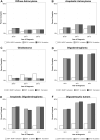Completeness of required site-specific factors for brain and CNS tumors in the Surveillance, Epidemiology and End Results (SEER) 18 database (2004-2012, varying)
- PMID: 27418206
- PMCID: PMC5071143
- DOI: 10.1007/s11060-016-2217-7
Completeness of required site-specific factors for brain and CNS tumors in the Surveillance, Epidemiology and End Results (SEER) 18 database (2004-2012, varying)
Abstract
Cancer registries are an important source of population-level information on brain tumor incidence and survival. Surveillance, Epidemiology, and End Results (SEER) registries currently collect data on specific required factors related to brain tumors as defined by the American Joint Commission on Cancer, including World Health Organization (WHO) grade, MGMT methylation and 1p/19q codeletion status. We assessed 'completeness', defined as having valid values over the time periods that they have been collected, overall, by year, histology, and registry. Data were obtained through a SEER custom data request for four factors related to brain tumors for the years 2004-2012 (3/4 factors were collected only from 2010 to 2012). SEER*Stat was used to generate frequencies of 'completeness' for each factor overall, and by year, histology and registry. The four factors varied in completeness, but increased over time. WHO grade has been collected the longest, and showed significant increases in completeness. Completeness of MGMT and 1p/19q codeletion was highest for glioma subtypes for which testing is recommended by clinical practice guidelines. Completeness of all factors varied by histology and cancer registry. Overall, several of the factors had high completeness, and all increased in completeness over time. With increasing focus on 'precision medicine' and the incorporation of molecular parameters into the 2016 WHO CNS tumor classification, it is critical that the data are complete, and factors collected at the population level are fully integrated into cancer reporting. It is critical that cancer registries continue to collect established and emerging prognostic and predictive factors.
Keywords: 1p/19q codeletion; Brain tumors; Cancer registration; MGMT methylation; WHO grade.
Conflict of interest statement
Compliance with ethical standards: Conflict of interest: There are no conflicts of interest to report.
Figures



References
-
- Surveillance Epidemiology and End Results (SEER) program required SEER site-specific factors for collaborative stage. http://seer.cancer.gov/tools/ssf/
-
- Kleihues P, Cavenee W, editors. Tumours of the nervous system: World Health Organization Classification of tumours. IARC Press; Lyon: 2000.
-
- Louis D, Wiestler O, Cavanee W, editors. WHO Classification of tumours of the central nervous system. International Agency for Research on Cancer; Lyon: 2007.
-
- American Joint Committee on Cancer. Collaborative stage data collection system. 2015 http://www.cancerstaging.org/cstage/
-
- Louis DN, Perry A, Reifenberger G, von Deimling A, Figarella-Branger D, Cavenee WK, Ohgaki H, Wiestler OD, Kleihues P, Ellison DW. The 2016 World Health Organization classification of tumors of the central nervous system: a summary. Acta Neuropathol. 2016;131:803–820. doi: 10.1007/s00401-016-1545-1. - DOI - PubMed
Publication types
MeSH terms
Substances
Grants and funding
LinkOut - more resources
Full Text Sources
Other Literature Sources
Research Materials

